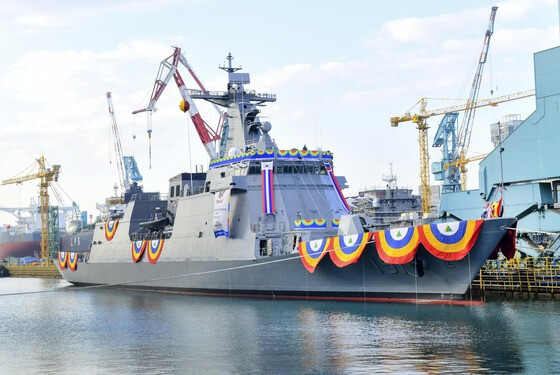
Ulsan, South Korea – The Philippine Navy marked another significant milestone in its modernization efforts with the ceremonial launch of its second Miguel Malvar-class guided-missile corvette, the BRP Diego Silang (FFG-07), at the HD Hyundai Heavy Industries (HD HHI) shipyard in Ulsan, South Korea, on Thursday, March 27, 2025. The event, officially held on Friday, March 28, signifies the continued strengthening of the Philippines' naval capabilities through its ongoing partnership with South Korea.
The BRP Diego Silang is the second of two 3,200-ton corvettes ordered by the Philippine government from HD HHI as part of the Armed Forces of the Philippines (AFP) Modernization Program's Horizon projects. This program aims to enhance the country's defense capabilities across its military branches.
The first ship of the class, BRP Miguel Malvar (FFG-06), which was launched in June 2023, is on track for delivery on March 31, 2025 – a remarkable five months ahead of the original schedule. The BRP Miguel Malvar is anticipated to arrive at its homeport in Subic Bay on April 8, 2025.
Named in honor of Diego Silang, a prominent Filipino revolutionary leader who fought for independence during the Spanish colonial period, the newly launched corvette will now undergo a period of outfitting and rigorous sea trials. Following successful completion of these tests, the BRP Diego Silang is slated for delivery to the Philippine Navy in September 2025, further bolstering the nation's maritime security.
The acquisition of these advanced corvettes is a key component of the Philippine government's commitment to modernizing its naval fleet. Through its Horizon programs, the Philippines has forged a strong relationship with HD HHI, resulting in orders for a total of ten vessels. This includes two Jose Rizal-class frigates ordered in 2016, the two Miguel Malvar-class corvettes ordered in 2021, and six Offshore Patrol Vessels contracted in 2022.
Highlighting the strength of this partnership, HD HHI has also secured Maintenance, Repair, and Overhaul (MRO) contracts for the two BRP Jose Rizal-class frigates, which were delivered to the Philippine Navy in 2020 and 2021. This ongoing support ensures the operational readiness and longevity of the Philippine Navy's crucial assets.
During the launching ceremony, Sang-kyun Lee, President of HD Hyundai Heavy Industries, expressed his satisfaction with the progress of the program. "We are very pleased to have successfully launched the second patrol vessel for the Philippines, following the first," he stated. "We will continue to actively support the successful modernization of the Philippine military."
The Miguel Malvar-class corvettes represent a significant leap in capability compared to the preceding Jose Rizal-class frigates. These new vessels boast a length of 118.4 meters and a beam of 14.9 meters. They have a cruising speed of 15 knots (approximately 28 kilometers per hour) and an impressive range of 4,500 nautical miles (8,330 kilometers), allowing for extended operational deployments.
Equipped with state-of-the-art weapon systems, the Miguel Malvar-class corvettes significantly enhance the Philippine Navy's combat readiness. Their arsenal includes C-STAR anti-ship missiles for engaging surface targets, a vertical launch system (VLS) for VL MICA (Vertical Launch MICA) surface-to-air missiles to counter aerial threats, and advanced 3D Active Electronically Scanned Array (AESA) radar for superior situational awareness and target tracking.
Given their enhanced size and advanced capabilities, there is an expectation within naval circles that the Miguel Malvar-class corvettes will be reclassified as frigates, superseding the Jose Rizal-class in terms of size and overall combat power within the Philippine fleet.
The launch of the BRP Diego Silang underscores the Philippines' unwavering commitment to strengthening its maritime security and protecting its national interests. As these modern vessels enter service, they will play a crucial role in safeguarding the country's territorial waters and contributing to regional stability.
[Copyright (c) Global Economic Times. All Rights Reserved.]



























